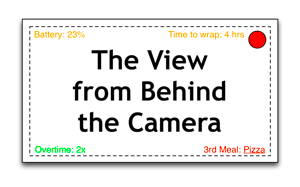Log and raw are not the same thing, and they are good for different things.
Here’s how I differentiate the two…
 The first thing we need to do is define one against the other. Raw and log are occasionally used interchangeably, and some raw formats incorporate log, so it’s important to be clear about what we’re discussing:
The first thing we need to do is define one against the other. Raw and log are occasionally used interchangeably, and some raw formats incorporate log, so it’s important to be clear about what we’re discussing:
Raw records data in such a way that the values from individual red, green and blue photosites on the sensor are preserved for deBayering/demosaicing in post. The value of this is that demosaicing algorithms generally improve over time, so it’s possible to go back and revisit old footage with new algorithms and make it look even better than it did at the time it was captured.
Log stores pixel information, not photosite information. Photo sites–the light sensitive wells on the surface of a sensor that collect photons–are the most basic unit of imaging in a camera, but in a single sensor camera they only represent one color: red, green or blue. A pixel, or picture element, is a point of information that results from converting those photosites into red, green AND blue information. A green photosite is stored individually in raw, but in log it is combined with information from blue and red photosites adjacent to it to create a full color RGB pixel. It is impossible to recreate individual photosite information from a pixel.
We’re going to talk about linear and log gamma now, so if you need a primer check out this article I wrote quite a while ago. I’ve since learned that my conclusion in that article, that log is basically as good an option as raw, is not accurate, but the rest is good information. What I learned after writing this article is that RGB photo site data can be hugely valuable as demosaicing software evolves, because you can then go back to the original photosite data with a new software algorithm and do a better job of demosaicing it.
There are lots of different kinds of raw. RED Raw is advertising as linear raw, although there are levels of compression that can be applied to make the amount of data manageable. Higher compression ratios can compromise image quality, but many of the options are perfectly viable (as a camera rental house once told me, “The worst compression on an Epic is still better than the best compression on a RED One”). In RED Raw, white balance and ISO are metadata and it’s easy to change both later.
Sony Raw is similar in that it consists of linear gamma-encoded data that has been lightly compressed.
In Canon Raw white balance and ISO are baked in. Canon says that this is to reduce noise in the image and create consistent dynamic range: whereas the distribution of stops above and below middle gray shift in Arri and RED cameras, they don’t change at all in the Canon C500. Every ISO gives you the same dynamic range spread. Canon Raw, however, is not linear encoded–it is log encoded. While the RGB photosite values are preserved most of the extraneous highlight values are discarded, particularly in the highlights.
Arri Raw is similarly log encoded, and I saw some demonstration footage last year that showed me that it is ridiculously easy to pull detail out of log-encoded raw data. In a shot of a space shuttle launch the flames from the rockets were a white blur in ProRes 4444 log but beautifully detailed in properly processed log-encoded raw.
It blew my mind a little when I learned that raw files can be log encoded, but it makes sense if we define raw the way I did above. Raw is not defined by gamma; raw can be log or linear gamma encoded. Raw is not the same as “log,” though, as we normally speak of log, because classically defined log footage has RGB photo site values “baked in” to pixel form. We really need separate terms to define all of these: linear raw, log raw, metadata raw, baked-in raw, etc. Sadly, right now, all we have are “raw” and “log.”
So I’m throwing down this gauntlet:
“Log” shall only refer to footage where the most basic picture information is preserved as pixels with RGB values.
“Raw” shall only refer to footage where the most basic picture information is preserved as photosite data with a single R, G or B value.
About the Author

Director of photography Art Adams knew he wanted to look through cameras for a living at the age of 12. After ten years in Hollywood working on feature films, TV series, commercials, music videos, visual effects and docs he returned to his native San Francisco Bay Area, where he currently shoots commercials and high-end corporate marketing and branding projects.
When Art isn’t shooting he consults on product design and marketing for a number of motion picture equipment manufacturers. His clients have included Sony, Arri, Canon, Tiffen, Schneider Optics, PRG, Cineo Lighting, Element Labs, Sound Devices and DSC Labs.
His writing has appeared in HD Video Pro, American Cinematographer, Australian Cinematographer, Camera Operator Magazine and ProVideo Coalition. He is a current member of the International Cinematographers Guild, and a past active member of the SOC and SMPTE. His website is at www.fearlesslooks.com. Find him on Twitter: @artadams.
